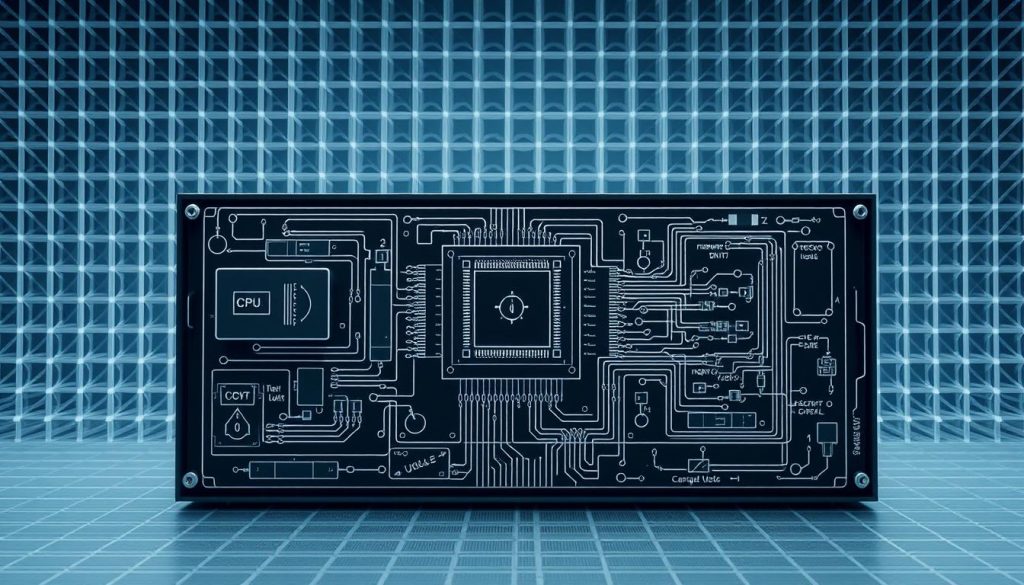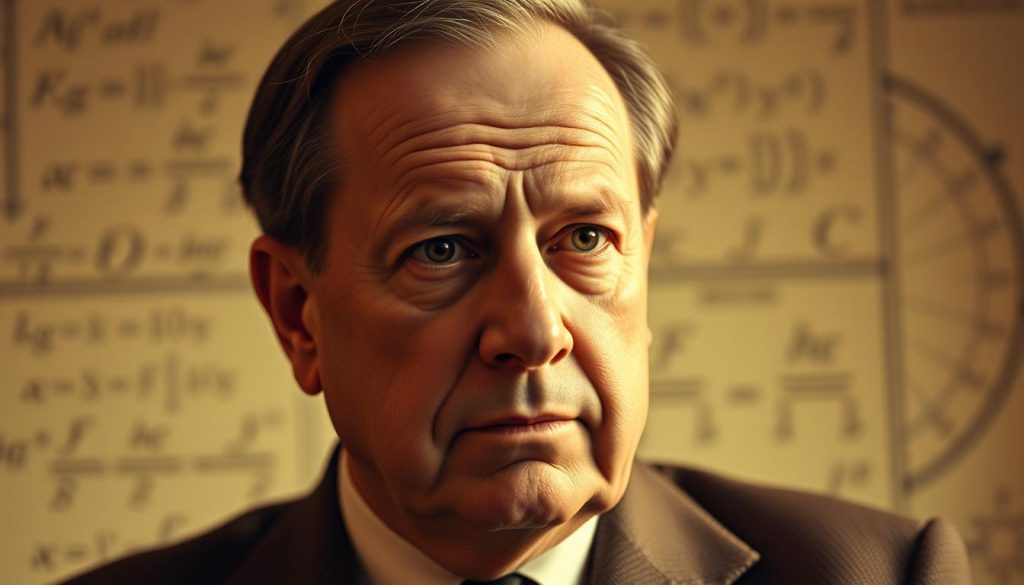Can one person change many fields at once? John von Neumann, a Hungarian-American genius, did just that. He was a mathematician, physicist, computer scientist, and engineer. His work changed science and technology forever.
We’re going to look at the life and achievements of this amazing person. Born in Hungary, von Neumann made big impacts in math, physics, economics, and computer science. His innovative thinking and problem-solving skills were unmatched.
His work on the Manhattan Project and creating the modern computer shows his visionary approach. We’ll see how von Neumann’s work still shapes science and technology today.
Key Takeaways
- John von Neumann’s work had a significant impact on multiple fields, including mathematics, physics, and computer science.
- His contributions to the Manhattan Project and modern computer development are still influential today.
- Von Neumann’s innovative thinking and problem-solving skills made him a visionary in his field.
- His work continues to shape modern science and technology.
- John von Neumann’s legacy serves as an inspiration to students and lifelong learners alike.
Early Life and Education
John von Neumann was born into a wealthy Jewish family in Budapest, Hungary. His early life was filled with privilege and a love for learning. His family helped nurture his incredible talent from a young age.
Childhood in Budapest (1903-1921)
In Budapest, von Neumann was surrounded by culture and top-notch education. His parents saw his talent early and gave him the best education possible.
Educational Background at University of Budapest
Von Neumann started at the University of Budapest, studying chemistry first. Then, he moved to mathematics. This time at university was key for his future in math.
Early Signs of Mathematical Brilliance
As a child, von Neumann was already showing off his math skills. He could solve complex problems easily and understood math deeply. These early signs hinted at his future as a leading mathematician, making important john von neumann contributions to many fields.
Academic Journey and Career Path
John von Neumann’s journey was a mix of Europe and the United States. It changed the world of math and computer science. His career was filled with key moments, from his early days in Europe to his work in the U.S.
University Years in Europe
Von Neumann started his studies in Europe. He was surrounded by deep mathematical traditions. He studied at the University of Budapest and later at the University of Berlin.
Immigration to the United States
In the 1930s, von Neumann moved to the United States. This change greatly influenced his career. He joined the academic community, making big contributions to American math and computer science.
Princeton and the Institute for Advanced Study
Von Neumann’s time at Princeton University and the Institute for Advanced Study was crucial. He worked with famous people, making big impacts in game theory and computer architecture.
| Institution | Period | Key Contributions |
|---|---|---|
| University of Budapest | 1921-1925 | Early mathematical explorations |
| Princeton University | 1930-1957 | Game theory, computer architecture |
| Institute for Advanced Study | 1933-1957 | Quantum mechanics, numerical analysis |
Von Neumann’s work had a lasting effect on computer science and math. He left a mark as one of the greatest minds of the 20th century.
The Genius of John von Neumann: A Mind Like No Other
John von Neumann was a true polymath. His mind was a powerhouse that changed science and math forever. His incredible abilities helped him make groundbreaking discoveries.
Extraordinary Mental Calculation Abilities
Von Neumann could do math in his head like nobody else. He solved complex problems fast and accurately. This skill was key in his work on game theory, where he made big strides.
Photographic Memory and Multilingualism
Von Neumann also had a photographic memory and spoke many languages. These gifts helped him learn and remember lots of info fast. His sharp memory was a big help in his research and work with others.
Testimonials from Scientific Contemporaries
People who worked with von Neumann called him a genius. His work on john von neumann inventions, like the Monte Carlo method, showed his creative mind. A colleague said, “Von Neumann was the last of the great mathematicians who could tackle any problem in mathematics.” This shows how much he was respected by his peers.
Von Neumann’s work still inspires many today. His mix of math talent, new ideas, and teamwork has made a lasting impact. He changed fields like computer science and economics.
Foundational Contributions to Mathematics
John von Neumann’s work in mathematics shows his incredible talent. He touched on many areas, from the basics to complex analysis. As a john von neumann mathematician, he helped start many math fields that still grow today.
Set Theory and Axiomatic Foundations
Von Neumann worked hard in set theory. He created the von Neumann-Bernays-Gödel (NBG) set theory. This set theory is key for modern math and its uses.
Ergodic Theory and Statistical Mechanics
In ergodic theory, von Neumann made big steps. He proved the mean ergodic theorem. This theorem changed how we understand physical systems over time.
Functional Analysis and Operator Theory
Von Neumann also made big impacts in functional analysis and operator theory. His work on quantum mechanics led to von Neumann algebras. These are important in studying operator algebras.
Continuous Geometry
He also explored continuous geometry. This field makes geometry work in continuous dimensions. His work helped us understand geometric structures better.
These john von neumann contributions show he was a key figure in 20th-century math. His work still affects many math areas today.
John von Neumann’s Achievements in Quantum Physics
Von Neumann’s work in quantum physics was groundbreaking. He helped us understand quantum mechanics better. His work also set the stage for new discoveries.
Mathematical Foundations of Quantum Mechanics
Von Neumann’s work on quantum mechanics was key. He created a solid math base for quantum theory. This math, based on Hilbert spaces and operator algebras, is still crucial today.
Key aspects of his work include:
- Development of the mathematical theory of Hilbert spaces
- Application of operator algebras to quantum mechanics
- Formulation of quantum mechanics in terms of abstract Hilbert spaces
Collaboration with Einstein, Bohr, and Heisenberg
Von Neumann didn’t work alone. He teamed up with giants like Albert Einstein, Niels Bohr, and Werner Heisenberg. These partnerships shaped his views and helped grow the field.
Quantum Logic and Measurement Theory
Von Neumann also made big strides in quantum logic and measurement theory. His work on quantum mechanics led to new insights on measurement and quantum logic. These ideas still shape quantum research today.
The implications of his work are profound:
- Understanding the limits of measurement in quantum systems
- Developing a rigorous framework for quantum logic
- Influencing the development of quantum information theory
Revolutionary Computer Science Contributions
Von Neumann’s work in computer science was groundbreaking. His ideas shaped modern computing. They have influenced many in the field.
The von Neumann Architecture
The von Neumann architecture is key in computer design today. It brought innovations that are still important.
Stored Program Concept
The stored program concept was a big leap. It made computers more flexible and efficient. This idea helped create modern software.
Memory and Processing Unit Design
Von Neumann’s design improved memory and processing units. This made data processing faster and systems more efficient.
EDVAC and First-Generation Computers
The EDVAC was the first computer to use von Neumann’s architecture. It set the stage for future computers, shaping computer science.
EDVAC had important features:
- Binary code for data
- Stored program concept
- Improved speed and efficiency
Self-Replicating Machines and Cellular Automata
Von Neumann explored self-replicating machines and cellular automata. His research has influenced artificial life and computational biology.

Von Neumann’s work in computer science has had a lasting impact. His ideas still shape computer design and research today.
Game Theory: Inventing a New Mathematical Discipline
Von Neumann, working with Oskar Morgenstern, started game theory. This new field helps us understand strategic decisions in competitive situations. It shows how actions of many can affect the outcome.
Development of Game Theory
Von Neumann and Morgenstern’s work on game theory was a big step. Their book, “Theory of Games and Economic Behavior,” gave a solid math framework for competitive interactions.
Zero-Sum Games and the Minimax Theorem
Zero-sum games are key in game theory. Here, one player’s win is another’s loss. Von Neumann’s minimax theorem found the best strategy for these games. It shows how to minimize loss or maximize gain.
| Concept | Description | Application |
|---|---|---|
| Zero-Sum Games | Games where one player’s gain equals another’s loss | Economic competitions, military strategies |
| Minimax Theorem | Optimal strategy to minimize maximum loss | Decision-making in competitive scenarios |
Applications in Economics and Strategic Decision Making
Game theory has big uses in economics, politics, and military planning. It helps us understand and make smart choices in complex situations.
Nash Equilibrium and von Neumann’s Influence
John Nash later built on von Neumann’s ideas with the Nash equilibrium. It’s a state where no player can better their outcome by changing strategy alone, assuming others don’t change.
Von Neumann’s work on game theory shows his creative math approach. His ideas still shape many fields, from economics to strategic planning.
John von Neumann Inventions and Technological Innovations
Von Neumann’s work has greatly influenced modern science. He made significant contributions in many fields, including mathematics and computer science. His ideas still shape today’s research and technology.
Monte Carlo Method for Statistical Sampling
The Monte Carlo method was created by von Neumann and his team. It’s a way to solve complex problems by using random sampling. This method is now key in finance, engineering, and physics.
Numerical Weather Prediction
Von Neumann was a pioneer in using computers for weather forecasting. His work laid the foundation for today’s weather models.
Middle Square Method for Random Number Generation
The middle square method is another of von Neumann’s inventions. It’s a way to generate random numbers. While it has its flaws, it was a big step in creating random number algorithms.
| Innovation | Description | Impact |
|---|---|---|
| Monte Carlo Method | Statistical sampling technique | Widely used in finance, engineering, and physics |
| Numerical Weather Prediction | Using computers for weather forecasting | Revolutionized meteorological modeling |
| Middle Square Method | Algorithm for random number generation | Influenced development of random number generation |
Von Neumann’s visionary approach to solving problems is evident in his work. His contributions continue to motivate scientists and researchers today.
Contributions to Nuclear Physics and the Manhattan Project
During World War II, John von Neumann joined the Manhattan Project. He brought his amazing math skills to nuclear research. His work at Los Alamos was key to the project’s success.
Role in the Manhattan Project at Los Alamos
Von Neumann was a huge help to the Manhattan Project team. He worked with famous scientists to create nuclear weapons. His math skills were essential for solving the project’s tough problems.
“Von Neumann’s ability to think abstractly was unmatched,” said a colleague. This shows how he was a unique asset to the team.
Implosion Design for Nuclear Weapons
Von Neumann made a big impact with his work on nuclear weapon design. He suggested using shaped charges to compress the plutonium core. This idea was both new and crucial for the project’s success.

Computational Methods for Nuclear Research
Von Neumann was also key in developing computer methods for nuclear research. He saw how computers could simulate complex physics. This laid the foundation for future nuclear physics breakthroughs.
His work on the Monte Carlo method was very influential. It helped scientists model and predict nuclear reactions. This greatly advanced the field.
Ethical Considerations and Cold War Influence
The creation of nuclear weapons raised big ethical questions. Von Neumann’s work in the Manhattan Project and later in nuclear physics was controversial. We must think about the ethics of his contributions.
Von Neumann’s legacy shows the complex relationship between science and its use. His work still shapes debates on scientific ethics and global security today.
Von Neumann’s Approach to Problem Solving
John von Neumann was known for his unique way of solving problems. He was great at combining different fields like game theory and inventions. This skill helped him tackle complex issues from many sides.
Interdisciplinary Thinking
Von Neumann’s work spanned many areas, including mathematics, physics, and economics. He used insights from these fields to find new solutions. For example, his work in game theory changed economics and also influenced political science and biology.
- Application of mathematical models to economic theory
- Integration of quantum mechanics into computational methods
- Use of statistical analysis in understanding complex systems
Mathematical Intuition and Abstraction
Von Neumann had a remarkable ability to simplify complex problems. He could turn them into math that was easy to work with. This skill helped him in quantum mechanics and computer science.
His work on the von Neumann architecture shows how he could make complex systems simple and efficient.
Some key aspects of his mathematical approach include:
- Development of new mathematical tools and theories
- Application of abstract algebra to physical problems
- Use of numerical methods to solve complex equations
Collaborative Work Style and Mentorship
Von Neumann worked well with others, often teaming up with famous scientists and mathematicians. His ability to mentor and collaborate was a big part of his success. Together, they could solve problems that were too big for one person.
Examples of his collaborative efforts include:
- Work with Oskar Morgenstern on game theory
- Contributions to the Manhattan Project at Los Alamos
- Development of early computer systems with colleagues at Princeton
Personal Life and Character
John von Neumann was a unique person. His life mixed intelligence, oddness, and kindness. Let’s dive into what made him special.
Family Relationships and Marriages
Von Neumann was married three times. His first was to Marietta Kövesi in 1930, which ended in divorce. His second marriage to Klari Dan in 1957 also ended in divorce. Yet, his third wife, Klari, stayed with him until his death. His family life was filled with love and strong bonds, despite the ups and downs.
Social Life and Famous Parties
Von Neumann loved parties and social events. He was the star of any gathering, known for his quick humor and charm. His ability to connect with people made him a favorite at social events.
Driving Habits and Non-Academic Interests
Von Neumann was known for his bold driving. Yet, he loved cars and enjoyed driving. He also had a deep interest in history and the arts, reading widely on these subjects.
John von Neumann was more than just a genius. He was a complex person with a rich personal life.
Conclusion: The Enduring Legacy of a Mathematical Visionary
John von Neumann’s work still influences many areas, like math, computer science, economics, and nuclear physics. His ideas have helped us innovate and understand complex systems better.
His impact is clear in modern computing, where his architecture is key. His game theory work has also shaped economics and strategic planning. Plus, his nuclear physics work was vital for the Manhattan Project.
Von Neumann’s achievements show his endless curiosity and wide-ranging knowledge. His life and work remind us of the value of thinking across disciplines. They highlight the need to keep exploring and expanding our knowledge.
Now, as we face the challenges of a fast-changing world, von Neumann’s legacy motivates future scientists, mathematicians, and thinkers. It encourages them to explore, innovate, and help shape our future.

